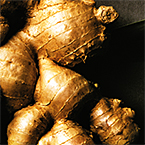Ginger

On this page:
Introduction
This fact sheet provides basic information about ginger—common names, what the science says, potential side effects and cautions, and resources for more information.
Ginger is a tropical plant that has green-purple flowers and an aromatic underground stem (called a rhizome). It is commonly used for cooking and medicinal purposes. Historically, ginger has been used in Asian medicine to treat stomach aches, nausea, and diarrhea. Today, ginger is used as a folk or traditional remedy for postsurgery nausea; nausea caused by motion, chemotherapy, and pregnancy; rheumatoid arthritis; osteoarthritis; and joint and muscle pain.
What the Science Says
- Studies suggest that the short-term use of ginger can safely relieve pregnancy-related nausea and vomiting.
- Studies are mixed on whether ginger is effective for nausea caused by motion, chemotherapy, or surgery.
- It is unclear whether ginger is effective in treating rheumatoid arthritis, osteoarthritis, or joint and muscle pain.
- NCCAM-funded investigators have looked at whether ginger interacts with drugs, such as those used to suppress the immune system, and ginger’s effects on reducing nausea and vomiting. Investigators are also studying:
- The general safety and effectiveness of ginger’s use for health purposes, as well as its active components and effects on inflammation.
- The effects of ginger dietary supplements on joint inflammation, rheumatoid arthritis, and osteoporosis.
Side Effects and Cautions
- Few side effects are linked to ginger when it is taken in small doses.
- Side effects most often reported are gas, bloating, heartburn, and nausea. These effects are most often associated with powdered ginger.
- Tell all your health care providers about any complementary health practices you use. Give them a full picture of what you do to manage your health. This will help ensure coordinated and safe care. For tips about talking with your health care providers about complementary and alternative medicine, see NCCAM's Time to Talk campaign.
Search the scientific literature for potential herb-drug interactions
Sources
- Ginger. Natural Medicines Comprehensive Database Web site. Accessed at www.naturaldatabase.com on July 6, 2009.
- Ginger (Zingiber officinale Roscoe). Natural Standard Database Web site. Accessed at www.naturalstandard.com on July 6, 2009.
- Ginger root. In: Blumenthal M, Goldberg A, Brinckman J, eds. Herbal Medicine: Expanded Commission E Monographs. Newton, MA: Lippincott Williams & Wilkins; 2000:153–159.
- Low Dog T. Ginger (Zingiber officinale). In: Coates P, Blackman M, Cragg G, et al., eds. Encyclopedia of Dietary Supplements. New York, NY: Marcel Dekker; 2005:241–248.
For More Information
NCCAM Clearinghouse
The NCCAM Clearinghouse provides information on NCCAM and complementary health approaches, including publications and searches of Federal databases of scientific and medical literature. The Clearinghouse does not provide medical advice, treatment recommendations, or referrals to practitioners.
PubMed®
A service of the National Library of Medicine (NLM), PubMed® contains publication information and (in most cases) brief summaries of articles from scientific and medical journals.
Office of Dietary Supplements (ODS), National Institutes of Health (NIH)
ODS seeks to strengthen knowledge and understanding of dietary supplements by evaluating scientific information, supporting research, sharing research results, and educating the public. Its resources include publications (such as Dietary Supplements: What You Need to Know), fact sheets on a variety of specific supplement ingredients and products (such as vitamin D and multivitamin/mineral supplements), and the PubMed® Dietary Supplement Subset.
NIH National Library of Medicine's MedlinePlus
This publication is not copyrighted and is in the public domain. Duplication is encouraged.
* Note: PDF files require a viewer such as the free Adobe Reader.
